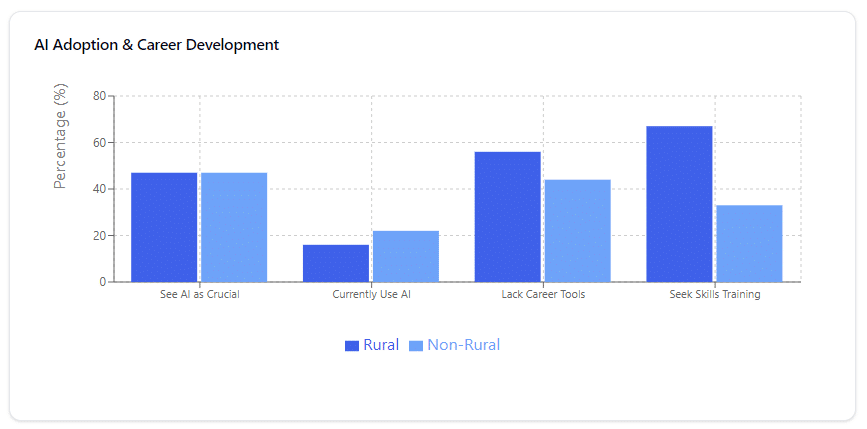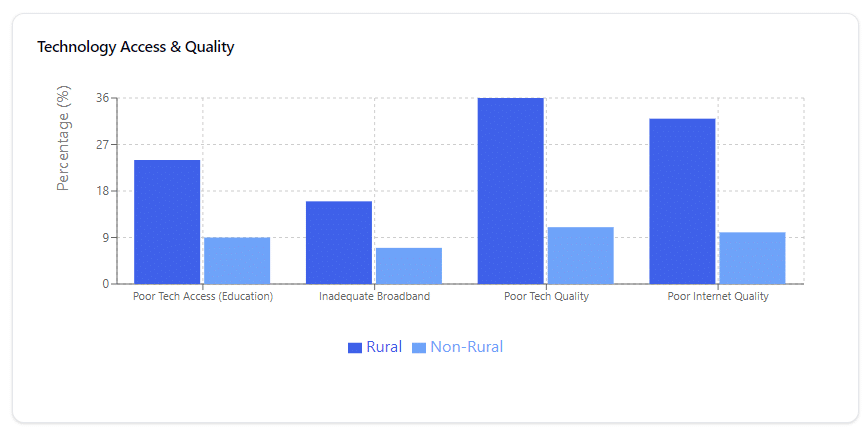Rural American workers face significant hurdles in career advancement in an increasingly digital workplace, according to a new joint study by the University of Phoenix Career Institute and the Center on Rural Innovation. The research, comparing 1,000 rural and 986 nonrural U.S. workers surveyed in mid-2024, reveals an opportunity gap between rural and urban areas, indicating a population where HR leaders might surface untapped talent.
While work roles in urban areas often promote skills training, artificial intelligence and remote work opportunities, the data shows that rural communities remain largely cut off from these advances. This study reveals that many benefits employees enjoy in today’s evolving workplace—including upskilling programs, AI tools and location flexibility—are primarily flowing to urban workers, leaving their rural counterparts at risk of falling further behind.
“Despite a seeming shift towards geographically agnostic career opportunities, the rural workforce continues to feel left behind and under-leveraged, often unable to access the work or education they desire,” write the report’s authors. They found rural inequality widening due to fewer business networks, limited technology infrastructure and scarce local educational resources in rural areas.
The findings paint a concerning picture: Three-quarters of rural workers with limited job prospects have contemplated relocating for better opportunities—a significantly higher rate than the 50% of their urban counterparts. Financial pressures weigh heavily on rural communities, with 58% struggling to pay bills (compared to 49% of non-rural workers) and 40% worried about supporting their families (versus 25% in urban areas).
The digital divide remains a critical issue, particularly regarding education and career. Rural workers face nearly triple the rate of technology access problems for education at all levels—while broadband access issues affect more than twice as many rural workers as their urban peers.
Overall tech quality ratings show an even wider gap—36% of rural residents report poor technology quality, more than three times the rate of urban residents. Internet service follows a similar pattern, with 32% of rural workers rating it poor or fair, compared to 10% of urban workers.
While artificial intelligence could promote work-life balance and productivity, rural workers lag in adoption despite recognizing its importance. Though nearly half see AI as vital to their career future, only 16% currently use it—below the 22% adoption rate among urban workers. More broadly, 56% of rural workers feel they lack proper career development tools, and two-thirds seek skills training opportunities.
This suggests that HR leaders looking to boost their workforce with employees eager to learn these new skills should look at the potential of hiring rural workers, particularly if remote positions are available.

HR tech products and people in the news
Global labor market analytics company Lightcast launched its real-time skill insights solution on the SAP Store. This partnership will give HR leaders data to support skills enrichment, benchmarking and custom skill profiles. The release follows Lightcast’s recent expansion of data delivery options on platforms like Amazon S3, Azure and Databricks.
Trua, a provider of digital credentials, has been granted a patent for its method of creating dynamic trust profiles. This approach allows individuals to directly verify and manage their personal data. The innovation enables real-time verification and user-controlled data sharing, enhancing compliance and reducing fraud.
Bullhorn staffing solutions has launched an end-to-end solution to enhance efficiency and reduce overhead for staffing firms. Partnering with Eliassen Group, the solution streamlines processes and can handle over 20,000 weekly pay/bill transactions.
BambooHR announced its new AI-powered feature, Ask BambooHR, a chat-based interface that instantly answers employee questions. Revealed during BambooHR Customer Day, this tool aims to enhance efficiency for its more than 34,000 customers and millions of users worldwide.
AI-driven workforce solution Gloat has introduced two new products—Skills Planner and Studio—both within its Agile Workforce Operating System. These tools aim to help organizations identify skill gaps, build dynamic talent pools for targeted upskilling and enable talent reallocation to meet business needs.
Aquant AI service co-pilot released its Employee Burnout Prediction Model. This tool helps employers track and mitigate burnout risks by monitoring key workload factors like time since the last vacation and daily job completions. It also provides burnout assessments, identifying at-risk employees for targeted intervention.
ADP announced its acquisition of WorkForce Software, a provider of workforce management solutions for large global enterprises with capabilities in time and attendance, scheduling, forecasting, leave management and employee communications.
Pat Wadors announced that she has left her position as UKG’s chief people officer and joined Intuitive, which she calls a “purpose-driven med-tech company,” as its CHRO. “I’m so grateful for all that I learned and the people I was lucky to work with,” Wadors shared on LinkedIn.
More from HR Executive
Nine parliamentary elections will have taken place across Europe by the end of 2024. An August 2024 survey of HR professionals, many in senior leadership roles, revealed that election-related changes in employment regulations are a major concern. Find out what else is on their mind.
As 2024 winds down and you begin to formalize your HR technology strategies for next year, HR Tech Chair Steve Boese calls out some interesting and potentially important industry announcements made before and during the recent conference. See why he says they have the potential to make an impact.
It might seem like everyone is talking about new technology, but in some of the most specialized corners of the HR field, staying on top of innovation is second nature. Tiffany Paquette, director of people technology & operations at PUMA North America, is one of these pros. And I got to interview her!





